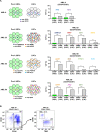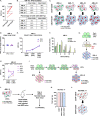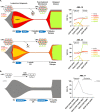Genomic analysis of cellular hierarchy in acute myeloid leukemia using ultrasensitive LC-FACSeq
- PMID: 34021247
- PMCID: PMC8606012
- DOI: 10.1038/s41375-021-01295-1
Genomic analysis of cellular hierarchy in acute myeloid leukemia using ultrasensitive LC-FACSeq
Erratum in
-
Correction: Genomic analysis of cellular hierarchy in acute myeloid leukemia using ultrasensitive LC-FACSeq.Leukemia. 2021 Dec;35(12):3627. doi: 10.1038/s41375-021-01398-9. Leukemia. 2021. PMID: 34480107 Free PMC article. No abstract available.
Abstract
Hematopoiesis is hierarchical, and it has been postulated that acute myeloid leukemia (AML) is organized similarly with leukemia stem cells (LSCs) residing at the apex. Limited cells acquired by fluorescence activated cell sorting in tandem with targeted amplicon-based sequencing (LC-FACSeq) enables identification of mutations in small subpopulations of cells, such as LSCs. Leveraging this, we studied clonal compositions of immunophenotypically-defined compartments in AML through genomic and functional analyses at diagnosis, remission and relapse in 88 AML patients. Mutations involving DNA methylation pathways, transcription factors and spliceosomal machinery did not differ across compartments, while signaling pathway mutations were less frequent in putative LSCs. We also provide insights into TP53-mutated AML by demonstrating stepwise acquisition of mutations beginning from the preleukemic hematopoietic stem cell stage. In 10 analyzed cases, acquisition of additional mutations and del(17p) led to genetic and functional heterogeneity within the LSC pool with subclones harboring varying degrees of clonogenic potential. Finally, we use LC-FACSeq to track clonal evolution in serial samples, which can also be a powerful tool to direct targeted therapy against measurable residual disease. Therefore, studying clinically significant small subpopulations of cells can improve our understanding of AML biology and offers advantages over bulk sequencing to monitor the evolution of disease.
© 2021. The Author(s).
Conflict of interest statement
The authors declare no competing interests.
Figures






References
Publication types
MeSH terms
Substances
Grants and funding
LinkOut - more resources
Full Text Sources
Other Literature Sources
Medical
Research Materials
Miscellaneous

